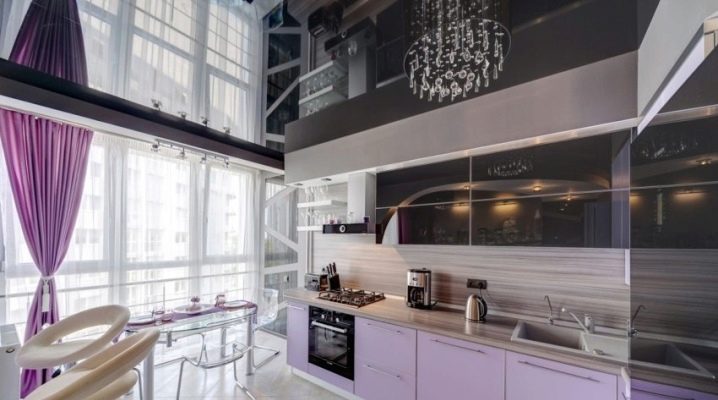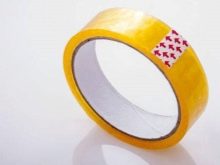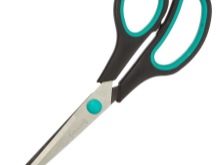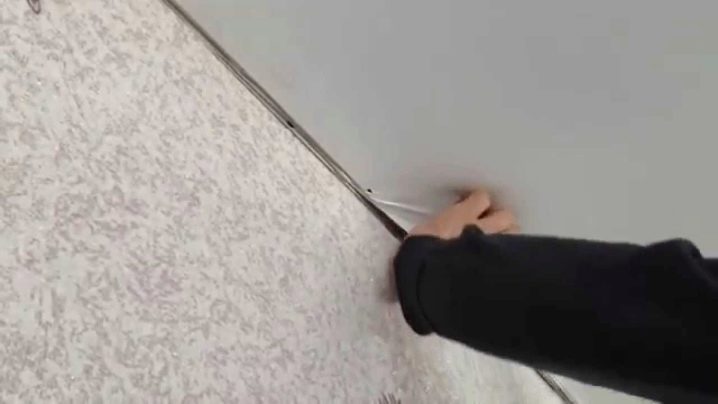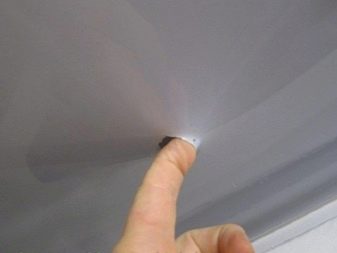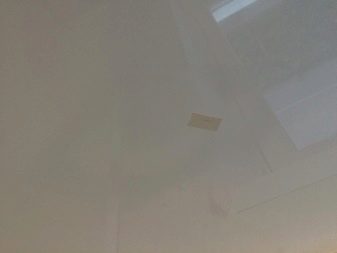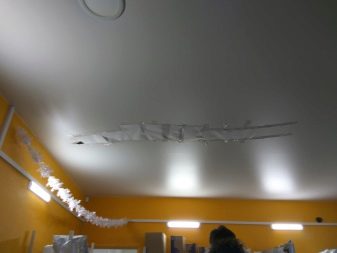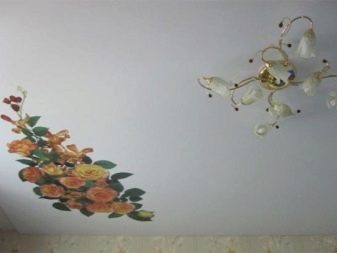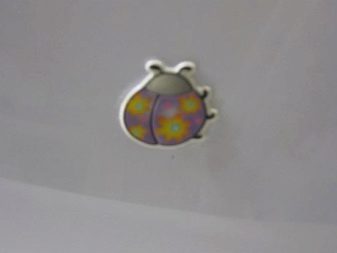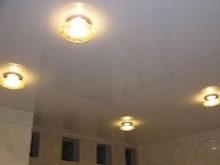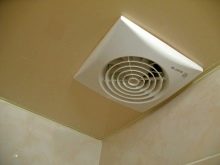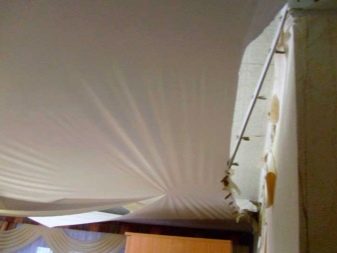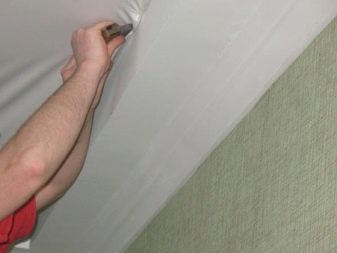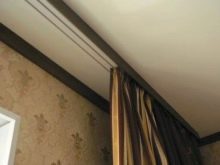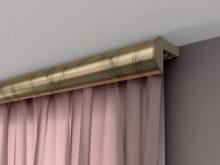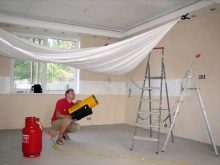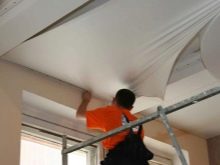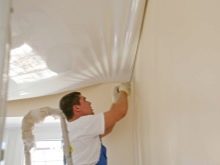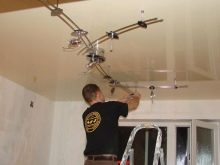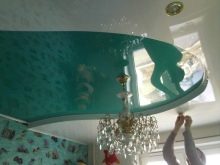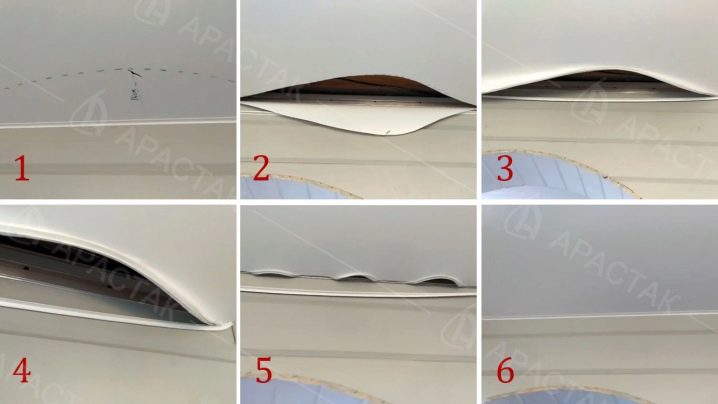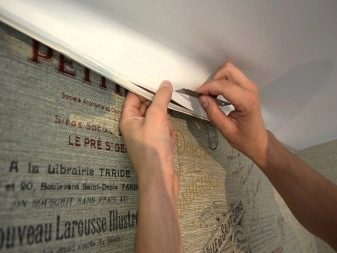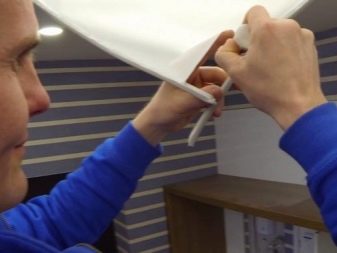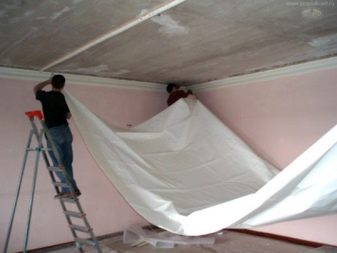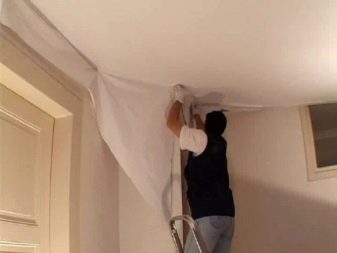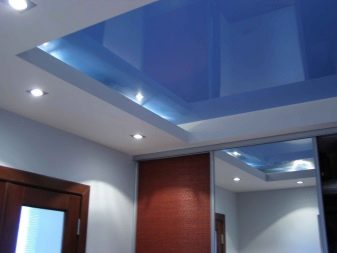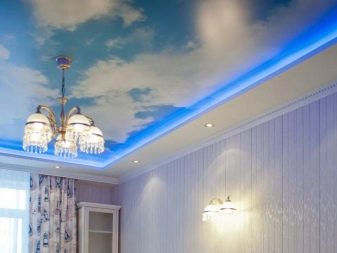How to seal the suspended ceiling?
To date, the stretch ceiling will surprise no one. Unfortunately, this material is quite fragile and can be easily damaged. The most frequent causes of breaking the stretch ceiling are moving furniture, changing curtains or curtains, opening champagne (when a cork just flies to the ceiling) and others. Immediately the question arises - how to correct the situation and try to glue the suspended ceiling?
Necessary materials
First you need to determine the scale of damage and their nature. Next, we determine how to correct the situation.
The standard repair kit looks like this:
- glue for painting works or, if there is no one near at hand, the superglue familiar to everyone is also suitable;
- special adhesive tape for glass surfaces;
- needle with kapron thread;
- scissors (suitable both regular and stationery).
There are several types of glue that can be used to repair suspended ceilings. His choice should be approached very responsibly, because the result of the repair depends on the quality of this substance.
Universal glue is used most often to combine a variety of materials. Can be used for bonding non-woven or vinyl wallpaper. The composition includes special resins that allow you to use it during repairs.
Special glue is used only for a certain type of wallpaper and textures. Manufacturers produce three types of glue: light (designed for gluing light materials), medium (can be used for gluing fabric or acrylic wallpaper) and heavy (used for gluing vinyl and non-woven wallpaper).
Try to use clear glue. This will help you visually hide the location of the repair and the defect on the ceiling.
Glue will be needed at the initial stage of installation of the stretch ceiling. It is necessary to prepare in advance and fix the plastic lining to tighten the fabric.The canvas will need to fill directly into the profile.
Do not forget that you should only start repairing yourself if the hole is less than ten centimeters.
If the hole is larger, use the services of professional installers.
If the hole is quite small, you can use the usual white tape. This option of easy repair may be suitable if the hole is no more than two centimeters, otherwise it is fraught with the fact that the edges will still disperse in the future and the hole will be much larger.
Repair options
The first step is to make a patch of the same material as the stretch ceiling. The size of the patch should be slightly larger than the hole itself. Next, apply a layer of glue on the patch and press it to the hole in the ceiling. Remember that you should not press in the patch, otherwise the excess adhesive will come out and will be visible to everyone around you. Carefully smooth out the patched place.
In case you do not have any remaining material, you can try to find a canvas that will match the color of your ceiling.
First you need to thoroughly clean the place for gluing adhesive tape. from dust and accumulated dirt. Cut a small piece of tape and secure it to the hole. If the hole is large, use the canvas. Attach a piece of material to the hole and glue well with adhesive tape.
If glue is chosen for repair, it is necessary to carefully study the instructions for it. Stick to it, and then your patch will be securely fixed on the surface of the stretch ceiling.
If the interior design allows, you can stick a patch in the form of an original application or turn on your imagination and even make a mosaic. But the most correct decision in this case is to appeal to professionals who will make repairs and seal the hole in the stretch ceiling without problems. If, however, it is impossible to glue the ceiling with improvised means, it is necessary to completely replace the material.
You can also make a fake ventilation - stick a small plastic grille to the place of the hole formation. Those who do not know the true reason for the appearance of this grille for ventilation will think that this is the way it should be.
Another winning option for plugging a hole in the ceiling is the installation of primary or secondary lighting. In case you do not need additional lighting, you can make a decoration - for this you will need to hang the ceiling or lamp in the place where the hole was formed. The installation of the scenery may be appropriate in the event that electrical wiring is not provided in this place.
If you decide that you need a real chandelier that will provide lighting, then remember that you need to hang it on a special hook that is mounted in the main ceiling. That is, if you do not foresee the presence of a hook, and no electrical wiring is done - you will have to completely disassemble the ceiling, hang the chandelier and reassemble the tensioning canvas. In this case, it will be cheaper to completely replace the torn stretch ceiling with a new one.
If a hole was formed in the seam, then it is necessary to contact the company that made the installation of the stretch ceiling. This will later be much cheaper for you in material terms than independent attempts to correct the situation, because then you still have to contact the installers.
How to minimize damage?
To avoid damage to the tension material, it is necessary to remember which basic actions lead to the appearance of holes:
- Installation of eaves. When inaccurate installation of eaves, there is a possibility that gaps may appear on the surface of the tension material. To minimize their appearance, it is necessary to install a small soft fabric gasket between the ceiling and the sharpest edges of the eaves. This will protect the material from the appearance of possible holes and unnecessary holes.
- Children's pranks. Children love to throw up a variety of items. Some of them may have sharp corners or ends, which lead to the appearance of unnecessary holes in the ceiling.
- Champagne. The inability to open a bottle of champagne or the wrong angle of inclination of the bottle, and the cork bounces off the bottle with great force up and tears the tension cover.
- During the works connected with installation, you should not strongly strain a cloth. In the future, this will contribute to the divergence of the material exactly along the seam line.
- It is imperative to fix all profiles and structures on which the fabric is stretched. Otherwise, in the future they may move away from the wall and in this way you will get a torn canvas.
- When installing luminaires do not forget that you need to choose the appropriate power.From high power luminaries, a thin sheet can simply melt. This rule concerns not only the built-in models, but also suspended lamps.
How to do it yourself?
The easiest to repair damage are those that are located directly at the edge of the web.
The algorithm of work in this case will be as follows:
- It is necessary to stretch the edge of the film from a baguette (about thirty centimeters on both sides of the defective place). The edge needs to be pulled out closest to the holes.
- Using a sharp knife, cut a strip that was tucked into a profile when the ceiling was first installed.
- Cut off the lower part of the harpoon (strip, refilled in profile).
- Using a sharp knife, cut the defective film in such a way that a curved line is obtained.
- Apply glue to the harpoon strip. Glue the fabric to this strip.
- Heat the hot air (use for this ordinary hair dryer) film. Tighten it with a spatula and tuck the harpoon in a baguette.
These actions are suitable for repair, if the hole in the stretch ceiling, for example, from the company Cosmofen, is not very big. If the unwanted hole is near the lighting or far from the perimeter of the ceiling, the situation becomes more complicated and requires the help of professionals.
Precautionary measures
The most common options for the appearance of unwanted holes in the tension version of the ceiling - this is improper operation, the use of low-quality materials, non-professional installation.
To minimize damage, follow the rules for installation and operation of tension fabrics:
- It is necessary to use only high quality materials. Use the services of specialists and companies that guarantee the quality of their work. The most common causes of ruptures, which are not due to mechanical interventions, are the deformation of the working surface, which is formed due to improper attachment of the profile and its lagging behind the wall. This can only happen due to improper installation.
- Try to keep children from throwing toys. Remember that even an ordinary ball can lead to the fact that the tension fabric is deformed. Such deformations can also occur as a result of too sharp raising of hands by tall people.
- Eaves for curtains or baguette must be installed very carefully. Try to use softening pads that are laid between the film and the baguette.
- PVC stretch ceiling is very beautiful and stylish looks. However, it requires careful maintenance. Unfortunately, with even a small flooding, a complete replacement of the stretch ceiling may be necessary. Such a canvas can protect your apartment from water, but it will need to be changed immediately - it is very quickly deformed and stretched.
- If, when installing a stretch ceiling, cheap and low-quality materials were used, then in the future this is fraught with slacking of the material or being pulled in (when the stretch ceiling material sticks to the concrete ceiling base). If the installation was made by a reliable company, then this defect relates to the warranty. We remind you that warranty cases are most often eliminated for free. The cut does not apply to such situations.
Do not forget also that it is better to eliminate the defects that appear as soon as you find them. This will allow quickly and without visible consequences to correct the situation.
How to eliminate a cut on the stretch ceiling, see the following video.
